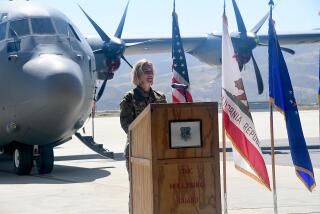40 AWOL Guardsmen Come Back : Reserves: Members of a Louisiana unit return to their posts in Texas, two days after leaving. They will face military charges.
- Share via
After two days of unauthorized absence, the 40 members of a Louisiana National Guard unit who walked off their central Texas post complaining about Army training and chow returned to duty Thursday to face punishment that could include confinement at hard labor, the Army said.
Some of the guardsmen from the 1st Battalion, 156th Armor, 256th Infantry Brigade, headquartered at Shreveport, La., left Fort Hood on Tuesday. They surfaced later at a Louisiana television station complaining of low morale, bad food, inadequate training and stressful conditions.
One of the returning soldiers said the group accomplished its goal of bringing attention to complaints of mistreatment and poor conditions.
“A lot of guys were frustrated and tired of being lied to about getting time off,” said Pvt. Eric Hall, an 18-year-old tank loader who left the base Tuesday night without a pass. “Just in anger, they said, ‘I’m leaving.’ ”
The guardsmen will not be punished as a group, the Army has said. Instead, each case will be considered individually.
Brig. Gen. Gary Whipple, commander of the 256th Infantry Brigade of the Louisiana Army National Guard, expressed disappointment that the men “sought to solve their problems in this manner.”
“I understand some of the soldiers had legitimate concerns about what we were doing and how we were doing it,” Whipple said at a news conference at Fort Hood, “but there are ways for these soldiers to voice their concerns properly.”
A senior Pentagon official said the guardsmen’s actions raised doubts about the viability of the military’s plan to use the National Guard to round out active-duty combat divisions.
“This is exactly what we were worried about,” said the official, who declined to be named. “There are a lot of things reserves can do, but you can’t ask them to go instantly into combat; that’s asking too much. They need more training, more time.”
Military lawyer Maj. John Odom said he went to KSLA-TV in Shreveport and spoke to five of the soldiers, whom he described as “young kids in blue jeans with their hands in their pockets and looking very confused and scared.”
“I am completely convinced they had not the foggiest notion of the gravity and seriousness of what they’d done,” Odom said. “They were grousing about chow, broken promises of time off and that central Texas is muddy and cold.”
By Thursday afternoon, nearly all of the missing soldiers had returned to Ft. Hood after spending two days in Shreveport with their families and friends.
“We expect all of the soldiers will have returned by later today,” said Whipple, after discussing the matter with the soldiers and their families.
Now, facing charges ranging from conspiracy to commit mutiny and desertion to absence without leave, Odom said, “their hearts may be with their mommies, but their bodies belong to Uncle Sam.”
After many complaints from National Guard officials and political supporters in Congress that the Guard was being slighted in the Persian Gulf deployment, Defense Secretary Dick Cheney late last year decided for the first time to call up three National Guard combat brigades to serve with their active-duty counterparts.
Cheney said they would undergo rigorous training and then be evaluated for their readiness to serve on the front lines in Saudi Arabia.
But doubts were soon raised about the fitness and readiness of the guardsmen.
One Army official said that fully half the soldiers in the three brigades had failed basic physical fitness standards for service in the military. Other officials said the guardsmen lacked basic small-unit fighting skills and could not be trained to fight in battalion- or brigade-sized maneuvers in less than six months.
Some Guard commanders have contended in recent weeks, however, that their soldiers are being held to higher standards than active-duty troops to prove the assertion by the active Army that the reserves are not up to the job.
The Shreveport unit, which originally was deployed to Ft. Polk, La., in December, moved to Ft. Hood in early January for platoon- and company-sized maneuver training in the use of the new M-1 tank and the Bradley Fighting Vehicle, the Army said.
At the end of this training in March, the entire brigade will move to the Army’s national training center at Ft. Irwin, Calif., for brigade-sized maneuvers.
Times researcher Lianne Hart contributed to this story.
More to Read
Sign up for Essential California
The most important California stories and recommendations in your inbox every morning.
You may occasionally receive promotional content from the Los Angeles Times.













